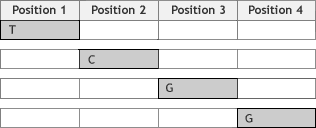Teachers' Domain - Digital Media for the Classroom and Professional Development
User: Preview






 Loading Standards
Loading StandardsIn this lesson, students will investigate a fictional anthrax case using paper to model the Sanger method of DNA sequencing. After receiving an envelope containing strips of paper that represent the incomplete copies of anthrax DNA from a suspected lab, students will sort the strips to determine the DNA sequence from that lab. Then, as a class, students will compare their sequences to the one found in the fictional anthrax-laced letter to determine which lab is guilty.
Students will be able to:
1. As a class, begin by watching the NOVA scienceNOW: Anthrax Investigation Video. Then, discuss students' questions about the segment.
2. Explain to students that they will be conducting their own investigation of a fictional anthrax case. Tell them that the Bacillus anthracis from different labs may have slightly different DNA, and this feature could be useful in the investigation. Ask: What would have caused the DNA differences, from lab to lab, in the first place?
3. To refresh students' understanding of DNA replication, show them the following animations (in the order suggested). Students may benefit from seeing the animations more than once.
As a class, review what mutations are and how they can cause differences among populations of bacteria in different labs. Relate the information in the animations to the NOVA scienceNOW: Anthrax Investigation video segment. Emphasize that mutations arise over time in a population, and they are the source of variation among the lab populations. This variation ultimately enables investigators to compare the anthrax DNA from different labs and find a match between the DNA found in the letter and the DNA from one of the labs.
4. Tell students that, to find a match, investigators first had to establish the DNA sequence of the Bacillus anthracis in the letter and also the sequences from the suspected labs. This activity employs a well-known type of DNA sequencing called the Sanger method. Show students the HHMI: Sanger Method of DNA Sequencing Video. If necessary, you can show the video multiple times or let students go through it individually or in small groups.
As a class, summarize the activity, and then relate the information in the activity to the Anthrax Investigation video segment. Help students define DNA sequencing as a technology used to determine the order of nucleotides in DNA.
5. Divide the class into pairs. Give each student the Anthrax Investigation Student Handout PDF Document, and distribute the envelopes containing DNA samples (one envelope per pair). Explain that the envelopes contain "anthrax" DNA samples from suspected labs, and that the samples have already undergone the first part of the Sanger sequencing process. Envelope contents represent many incomplete copies of the DNA strand, each one of a varying length and each one ending on the left with a "fluorescent" A, T, G, or C. Students will need to sort the copies by length and determine the sequence. For example, the sequence would be TCGG for strips aligned like this:

6. When student pairs have determined their anthrax DNA sequence, check their answers on their handout.
7. Have groups write their anthrax DNA sequences on the board. Make a chart to organize their responses. For example:

8. Ask the class to review the sequences and see if they can spot any differences.
9. On the board, write the anthrax DNA sequence found with the fictional "guilty" letter: TGACAATCAG. Ask if any group's sequence matches the one found in the "guilty" envelope. What is the significance of the match?
10. Ask students how the activity compares to the real investigation shown in the Anthrax program. Point out how important it is to have samples from every lab. Otherwise, the guilty lab might be missed.
11. Optional Extension Activities:
Remind students that genes are segments of DNA that are transcribed to mRNA and then translated into amino acids, the building blocks of proteins. Ask students to imagine that the DNA from this activity represents a small section of a gene. Ask them to transcribe and translate the DNA sequence. A table of the genetic code, usually found in biology textbooks, is required for this extension.
As a class, ask students to discuss how they were able to solve the anthrax mystery.
 Teachers' Domain is proud to be a Pathways portal to the National Science Digital Library.
Teachers' Domain is proud to be a Pathways portal to the National Science Digital Library.
